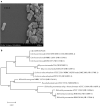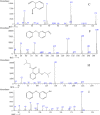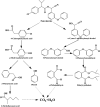Biodegradation and metabolic pathway of fenvalerate by Citrobacter freundii CD-9
- PMID: 33125615
- PMCID: PMC7599292
- DOI: 10.1186/s13568-020-01128-x
Biodegradation and metabolic pathway of fenvalerate by Citrobacter freundii CD-9
Abstract
Fenvalerate is a pyrethroid insecticide with rapid action, strong targeting, broad spectrum, and high efficiency. However, continued use of fenvalerate has resulted in its widespread presence as a pollutant in surface streams and soils, causing serious environmental pollution. Pesticide residues in the soil are closely related to food safety, yet little is known regarding the kinetics and metabolic behaviors of fenvalerate. In this study, a fenvalerate-degrading microbial strain, CD-9, isolated from factory sludge, was identified as Citrobacter freundii based on morphological, physio-biochemical, and 16S rRNA sequence analysis. Response surface methodology analysis showed that the optimum conditions for fenvalerate degradation by CD-9 were pH 6.3, substrate concentration 77 mg/L, and inoculum amount 6% (v/v). Under these conditions, approximately 88% of fenvalerate present was degraded within 72 h of culture. Based on high-performance liquid chromatography and gas chromatography-mass spectrometry analysis, ten metabolites were confirmed after the degradation of fenvalerate by strain CD-9. Among them, o-phthalaldehyde is a new metabolite for fenvalerate degradation. Based on the identified metabolites, a possible degradation pathway of fenvalerate by C. freundii CD-9 was proposed. Furthermore, the enzyme localization method was used to study CD-9 bacteria and determine that its degrading enzyme is an intracellular enzyme. The degradation rate of fenvalerate by a crude enzyme solution for over 30 min was 73.87%. These results showed that strain CD-9 may be a suitable organism to eliminate environmental pollution by pyrethroid insecticides and provide a future reference for the preparation of microbial degradation agents and environmental remediation.
Keywords: Biodegradation metabolites; Citrobacter freundii CD-9; Fenvalerate; Metabolic pathway; Response surface methodology.
Conflict of interest statement
All authors declare that they have no competing interests.
Figures






Similar articles
-
Whole genome sequencing and analysis of fenvalerate degrading bacteria Citrobacter freundii CD-9.AMB Express. 2022 May 6;12(1):51. doi: 10.1186/s13568-022-01392-z. AMB Express. 2022. PMID: 35523901 Free PMC article.
-
Isolation of Dibutyl Phthalate-Degrading Bacteria and Its Coculture with Citrobacter freundii CD-9 to Degrade Fenvalerate.J Microbiol Biotechnol. 2022 Feb 28;32(2):176-186. doi: 10.4014/jmb.2110.10048. J Microbiol Biotechnol. 2022. PMID: 35058397 Free PMC article.
-
Isolation and characterization of a Sphingomonas sp. strain F-7 degrading fenvalerate and its use in bioremediation of contaminated soil.J Environ Sci Health B. 2013;48(3):198-207. doi: 10.1080/03601234.2013.730299. J Environ Sci Health B. 2013. PMID: 23356341
-
Chemistry and fate of fenvalerate and esfenvalerate.Rev Environ Contam Toxicol. 2003;176:137-54. doi: 10.1007/978-1-4899-7283-5_3. Rev Environ Contam Toxicol. 2003. PMID: 12442505 Review.
-
New insights into the microbial degradation and catalytic mechanism of synthetic pyrethroids.Environ Res. 2020 Mar;182:109138. doi: 10.1016/j.envres.2020.109138. Epub 2020 Jan 14. Environ Res. 2020. PMID: 32069744 Review.
Cited by
-
Whole genome sequencing and analysis of fenvalerate degrading bacteria Citrobacter freundii CD-9.AMB Express. 2022 May 6;12(1):51. doi: 10.1186/s13568-022-01392-z. AMB Express. 2022. PMID: 35523901 Free PMC article.
-
Isolation of Dibutyl Phthalate-Degrading Bacteria and Its Coculture with Citrobacter freundii CD-9 to Degrade Fenvalerate.J Microbiol Biotechnol. 2022 Feb 28;32(2):176-186. doi: 10.4014/jmb.2110.10048. J Microbiol Biotechnol. 2022. PMID: 35058397 Free PMC article.
-
Unveiling six novel bacterial strains for fipronil and thiobencarb biodegradation: efficacy, metabolic pathways, and bioaugmentation potential in paddy soil.Front Microbiol. 2024 Oct 22;15:1462912. doi: 10.3389/fmicb.2024.1462912. eCollection 2024. Front Microbiol. 2024. PMID: 39502414 Free PMC article.
-
Degradation of Triazole Fungicides by Plant Growth-Promoting Bacteria from Contaminated Agricultural Soil.J Microbiol Biotechnol. 2024 Jan 28;34(1):56-64. doi: 10.4014/jmb.2308.08037. Epub 2023 Oct 26. J Microbiol Biotechnol. 2024. PMID: 37940179 Free PMC article.
References
-
- Bhatt P, Bhatt K, Huang YH, Lin ZQ, Chen SH (2020a) Esterase is a powerful tool for the biodegradation of pyrethroid insecticides. Chemosphere. 10.1016/j.chemosphere.2019.125507/j.chemosphere.2019.125507Bhatt P, Rene ER, Jagadeesh Kumar A, Zhang WP, Chen SH (2020b) Binding interaction of allethrin with esterase: Bioremediation potential and mechanism. Bioresource Technology. 10.1016/j.biortech.2020.123845 - PubMed
Grants and funding
- z1310525/The Key Scientific Research Fund of Xihua University
- 2018-YF05-00522-SN/the Technological Innovation Project of Chengdu Science and Technology Bureau
- 2019YJ0389/the Application Foundation Project of Sichuan Provincial Department of Science and Technology
- ycjj2019122/the Graduate Student Innovation Fund of Xihua University
LinkOut - more resources
Full Text Sources
Other Literature Sources

